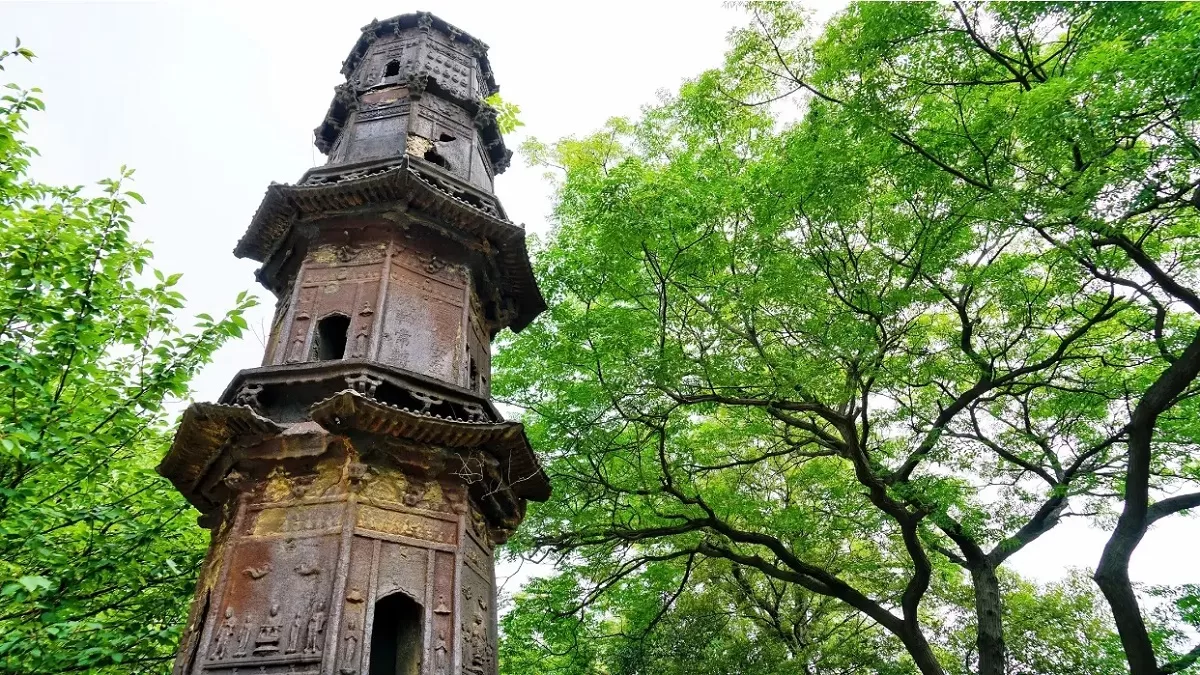The Iron Pagoda at Ganlu Temple, located in the Jingkou district of Zhenjiang city, Jiangsu province, China, is a remarkable architectural and cultural treasure that dates back to the Tang Dynasty. Originally known as the “Weigong Pagoda,” it was first constructed in the first year of the Baoli era (825 AD) during the Tang Dynasty by Li Deyu, a prominent statesman and the governor of Runzhou (modern-day Zhenjiang). The initial structure was a stone pagoda built to enshrine the relics of the deceased son of Emperor Mu (Tang Muzong).
The initial stone pagoda, unfortunately, suffered destruction during the Qianfu period of the Tang Dynasty (874-879 AD). However, it was not forgotten, as during the Xining period of the Song Dynasty (1068-1077 AD), precisely in the year 1078, the pagoda was meticulously reconstructed at its original site by Wang Anli, the regional governor. This time, the pagoda was reconstructed in iron, replicating the wooden architecture style. The newly built Iron Pagoda featured eight sides and nine levels.
Over the centuries, the Iron Pagoda faced various challenges, including natural disasters and wars. In the 10th year of the Wanli era (1582), it was toppled by a violent storm, leaving only the bottom three levels intact. Undeterred, the local monks initiated a fundraising effort to rebuild the pagoda, resulting in its transformation into a seven-level structure.
During the tumultuous events of the Opium War in 1842, the Iron Pagoda faced a new threat when invaders attempted to plunder it. However, due to the pagoda’s immense weight, they could only manage to carry away its precious top and pinnacle. Despite this, the main structure of the pagoda survived.
The challenges continued into the 19th century, as in the 22nd year of the Daoguang era (1842), the pagoda was struck by lightning and damaged. Subsequently, in the seventh year of the Tongzhi era (1868), the pagoda was further impacted by wind, rain, and thunder, resulting in a partial collapse.
The most significant restoration effort occurred in 1960 when the Zhenjiang municipal authorities embarked on a large-scale renovation project for the Iron Pagoda. During this restoration, the original third and fourth levels, which had been preserved inside the Ganlu Temple since the Ming Dynasty, were reattached to the pagoda. Additionally, during the excavation of the pagoda’s base, a hidden underground chamber dating back to the Tang and Song dynasties was discovered, containing relics and artifacts associated with the entombment of Buddhist relics.
The architectural features of the Iron Pagoda at Ganlu Temple are captivating. The octagonal pagoda stands approximately 8 meters tall, including its base (sūmèi zùo) and the remnants of its four levels. Each side of the pagoda features intricate patterns such as cloud and water motifs, lotus petals with paired birds, playful dragons, and depictions of Buddha and celestial beings. These decorative elements not only showcase ancient Chinese iron casting techniques but also reflect the artistic influences of Buddhism during the Song Dynasty.
The base of the Iron Pagoda is 1.75 meters high and nearly 1.3 meters wide on each side. The lower section is adorned with detailed motifs, including depictions of sea waves, lotus petals, and various mythical creatures. The midsection features seated figures of heavenly beings and phoenixes, showcasing the craftsmanship of the artisans.
The first level of the pagoda, rising 1.25 meters high with a diameter of over two meters, is decorated with eight doors and four high windows on each side. These openings are adorned with sculptures of Buddha, bodhisattvas, flying deities, dragons, and a variety of intricate patterns. The proportions and lively postures of these sculptures contribute to the overall aesthetic appeal of the Iron Pagoda.
In summary, the Iron Pagoda at Ganlu Temple stands not only as a testament to ancient Chinese iron casting and woodworking techniques but also as a symbol of resilience against the ravages of time and historical adversities. Its rich history, intricate design, and spiritual significance make it a valuable artifact for historical, scientific, and cultural research, offering visitors a glimpse into China’s profound cultural heritage.


